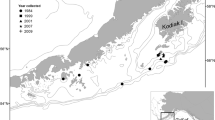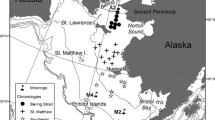Abstract
Increments in the hard parts of marine organisms (otoliths, skeletons, shells) can provide long-term chronologies of growth analogous to tree rings. For the first time in the Southern Hemisphere, we use a dendrochronological (tree-ring analysis) approach to develop a multidecadal chronology of growth for a temperate reef fish, Girella tricuspidata, from the coast of northern New Zealand. Growth patterns in the otoliths of this species were strongly synchronous among individual fish over a period spanning 27 years (1980–2006). We then compared our otolith chronology to climatic records and found strong positive correlations of growth with sea surface temperature, and weak negative correlations with the multivariate El Nino Southern Oscillation (ENSO) index. Strongest correlations were found between summer sea surface temperature and otolith growth. This relationship was consistent across all years and explained 44 % of the variation (y = −2.0 + 0.1785 × temperature, r 2 = 0.4367, P = 0.0002) in the G. tricuspidata growth chronology. Our study illustrates how otolith chronologies provide remarkable records of annual growth patterns over decadal time scales that will be useful for forecasting the likely effects of climate change on marine ecosystems.




Similar content being viewed by others
References
Anderson MJ, Millar RB (2004) Spatial variation and effects of habitat on temperate reef fish assemblages in northeastern New Zealand. J Exp Mar Biol Ecol 305:191–221
Balazik MT, Garman GC, Fine ML, Hager CH, McIninch SP (2010) Changes in age composition and growth characteristics of Atlantic sturgeon (Acipenser oxyrinchus oxyrinchus) over 400 years. Biol Lett 6:708–710
Baumann H, Conover DO (2011) Adaptation to climate change: contrasting patterns of thermal-reaction-norm evolution in Pacific versus Atlantic silversides. Proc R Soc B-Biol Sci 278:2265–2273
Black BA (2009) Climate-driven synchrony across tree, bivalve, and rockfish growth-increment chronologies of the northeast Pacific. Marine Ecol-Prog Ser 378:37–46
Black BA, Boehlert GW, Yoklavich MM (2005) Using tree-ring crossdating techniques to validate annual growth increments in long-lived fishes. Can J Fish Aquat Sci 62:2277–2284
Black BA, Boehlert GW, Yoklavich MM (2008a) Establishing climate-growth relationships for yelloweye rockfish (Sebastes ruberrimus) in the northeast Pacific using a dendrochronological approach. Fish Oceanogr 17:368–379
Black BA, Gillespie DC, MacLellan SE, Hand CM (2008b) Establishing highly accurate production-age data using the tree-ring technique of crossdating: a case study for Pacific geoduck (Panopea abrupta). Can J Fish Aquat Sci 65:2572–2578
Black BA, Copenheaver CA, Frank DC, Stuckey MJ, Kormanyos RE (2009) Multi-proxy reconstructions of northeastern Pacific sea surface temperature data from trees and Pacific geoduck. Palaeogeogr Palaeocl 278:40–47
Black BA, Schroeder ID, Sydeman WJ, Bograd SJ, Lawson PW (2010) Wintertime ocean conditions synchronize rockfish growth and seabird reproduction in the central California Current ecosystem. Can J Fish Aquat Sci 67:1149–1158
Black BA, Allman RJ, Schroeder ID, Schirripa MJ (2011a) Multidecadal otolith growth histories for red and gray snapper (Lutjanus spp.) in the northern Gulf of Mexico USA. Fish Oceanogr 20:347–356
Black BA, Schroeder ID, Sydeman WJ, Bograd SJ, Wells BK, Schwing FB (2011b) Winter and summer upwelling modes and their biological importance in the California Current Ecosystem. Global Change Biol 17:2536–2545
Campana SE, Thorrold SR (2001) Otoliths, increments, and elements: keys to a comprehensive understanding of fish populations? Can J Fish Aquat Sci 58:30–38
Cook ER (1985) A time-series analysis approach to tree-ring standardization
Dutil JD, Brander K (2003) Comparing productivity of North Atlantic cod (Gadus morhua) stocks and limits to growth production. Fish Oceanogr 12:502–512
Fritts HC (1976) Tree rings and climate. Academic Press, New York
Grissino-Mayer HD (2001) Evaluating crossdating accuracy: a manual and tutorial for the computer program COFECHA. Tree-Ring Res 57:205–221
Holmes RL (1983) Computer-assisted quality control in tree-ring dating and measurement. Tree-Ring Bull 43:69–78
Humphries P, Winemiller KO (2009) Historical impacts on river fauna, shifting baselines, and challenges for restoration. Bioscience 59:673–684
Lehodey P, Grandperrin R (1996) Influence of temperature and ENSO events on the growth of the deep demersal fish alfonsino, Beryx splendens, off New Caledonia in the western tropical South Pacific Ocean. Deep-Sea Res Part I-Oceanogr Res Papers 43:49–57
Limburg KE, Waldman JR (2009) Dramatic declines in North Atlantic diadromous fishes. Bioscience 59:955–965
Matta ME, Black BA, Wilderbuer TK (2010) Climate-driven synchrony in otolith growth-increment chronologies for three Bering Sea flatfish species. Marine Ecol-Prog Ser 413:137–145
Morrison M (1990) Ontogenetic shifts in the ecology of the parore, Girella tricuspidata. MSc thesis, University of Auckland
Morrongiello JR, Crook DA, King AJ, Ramsey DSL, Brown P (2011) Impacts of drought and predicted effects of climate change on fish growth in temperate Australian lakes. Global Change Biol 17:745–755
Neuheimer AB, Thresher RE, Lyle JM, Semmens JM (2011) Tolerance limit for fish growth exceeded by warming waters. Nat Clim Change 1:110–113
Pauly D (1995) Anecdotes and the shifting baseline syndrome of fisheries. Trends Ecol Evol 10:430
Portner HO, Peck MA (2010) Climate change effects on fishes and fisheries: towards a cause-and-effect understanding. J Fish Biol 77:1745–1779
Russell BC (1977) Population and standing crop estimates for rocky reef fishes of north-eastern New Zealand. NZ J Mar Freshwat Res 1:23–36
Rypel AL (2009) Climate-growth relationships for largemouth bass (Micropterus salmoides) across three southeastern USA states. Ecol Freshwater Fish 18:620–628
Rypel AL, Haag WR, Findlay RH (2009) Pervasive hydrologic effects on freshwater mussels and riparian trees in southeastern floodplain ecosystems. Wetlands 29:497–504
Secor DH, Dean JM, Campana SE (1995) Recent developments in fish otolith research. University of South Carolina Press, Columbia
Thresher RE, Koslow JA, Morison AK, Smith DC (2007) Depth-mediated reversal of the effects of climate change on long-term growth rates of exploited marine fish. Proc Nat Acad Sci USA 104:7461–7465
Trouet V, Taylor AH (2010) Multi-century variability in the Pacific North American circulation pattern reconstructed from tree rings. Climate Dyn 35:953–963
Wells BK, Grimes CB, Field JC, Reiss CS (2006) Covariation between the average lengths of mature coho (Oncorhynchus kisutch) and Chinook salmon (O. tshawytscha) and the ocean environment. Fish Oceanogr 15:67–79
Wigley TML, Briffa KR, Jones PD (1984) On the average value of correlated time-series, with applications in dendroclimatology and hydrometeorology. J Clim Appl Meteorol 23:201–213
Yamaguchi DK (1991) A simple method for cross-dating increment cores from living trees. Can J For Res 21:414–416
Acknowledgments
We acknowledge funding from the Ministry of Fisheries, New Zealand for collection of fish, Environment Institute, University of Adelaide for part funding BABs visit to Adelaide, a Lavern Weber visiting fellowship, and an ARC Future Fellowship (FT100100767) to BMG. We also acknowledge participants from the workshop in Adelaide where the initial chronology was developed. We thank Gretchen Grammer for producing Fig. 1.
Author information
Authors and Affiliations
Corresponding author
Additional information
Communicated by K. D. Clements.
Rights and permissions
About this article
Cite this article
Gillanders, B.M., Black, B.A., Meekan, M.G. et al. Climatic effects on the growth of a temperate reef fish from the Southern Hemisphere: a biochronological approach. Mar Biol 159, 1327–1333 (2012). https://doi.org/10.1007/s00227-012-1913-x
Received:
Accepted:
Published:
Issue Date:
DOI: https://doi.org/10.1007/s00227-012-1913-x




